Alistair is wrapping up the last of the fieldwork this week with some spraying.
He finished harvesting the maize last week. It yielded 12t/ac at 24% dry matter. Alistair says that he had one strip of maize and beans, with no sunflowers, and this did much better. Therefore, he will plant it again next year but he will reduce the rate of sunflowers.
He found it an easy crop to grow and is happy enough with how it went considering the sunflowers shaded out the maize a lot.
The spring beans were also wholecropped. They yielded 7.5t/ac at a dry matter of between 27 and 30%. Alistair was very happy with this, and says that some clover at the base of the plants helped to bulk up the beans, and it should provide good feeding for the milking cows.
Alistair direct drilled wheat into the stubbles of both these crops. He says that conditions were lovely, and even though the fields are quite wet in general, not one mark was left. Pre-emergence herbicides are being applied to these crops this week.
The winter barley that
was sown at the end of
September has emerged very
well and has three leaves. Alistair applied a post-emergence herbicide of Shooter to the crop at the full-rate, but he has been very disappointed with the weed control provided, especially with annual meadow grass, but also with some broadleaved weeds.
Therefore, he went in again last week and applied Octavia Met. He will also apply some manganese, zinc, and milk to the crop shortly.
The winter beans are just starting to emerge, while the spring oats that they were planted with should be killed off by the frost. The spring beans that were a companion crop to the failed oilseed rape are doing very well along with some oats that were broadcast onto the field. Alistair hopes to wholecrop this in April before planting maize.
The harvest finished for Pádraig last Wednesday night with the last 6ha of spring beans just before heavy rain arrived, and unusually, he had finished all of his winter planting except for this field beforehand. This field was then planted on Sunday morning to complete Pádraig’s winter planting plan.
Pádraig was sick of looking at the beans after waiting for so long to harvest them. He does not know the yield yet as they have not been delivered, but the moisture content is a minimum of 33% as the moisture meter will not read any higher than that. He has tipped them in the shed, but only at a height of 3ft and is turning them every morning to try to prevent them from heating.
Thirty acres of the spring beans were harvested on 11 October, and within 28 hours of starting to cut them, the field was fully planted with winter barley. The variety was Integral and the crop has emerged very nicely.
Pádraig is giving wheat one more chance on his farm as there is one field not suited to barley, and the seedlings are just starting to peep through. He has applied no herbicides yet as he was busy getting planting completed before showers of rain and the timings just did not suit.
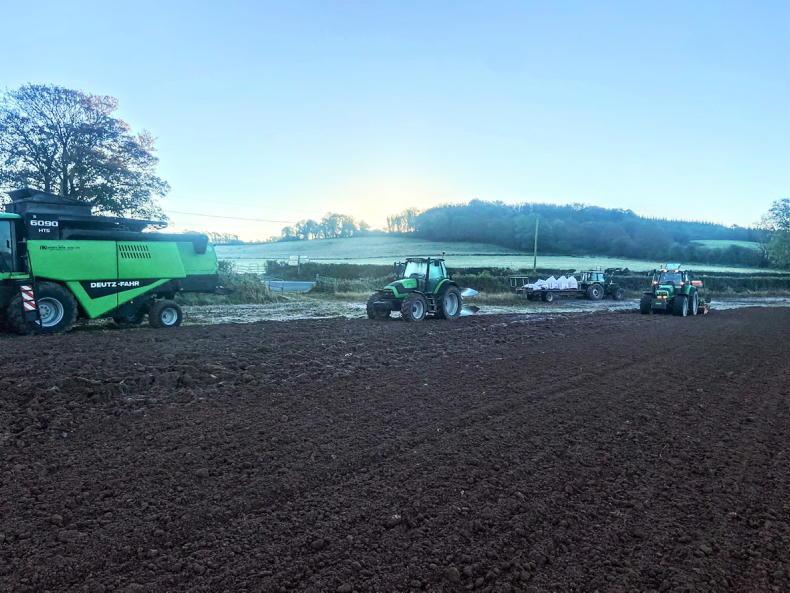
Pádraig had his combine, plough, and drill working in the same field recently.
The winter oats have also been planted. The varieties are WPB Isabel and Husky, which make up 60% and 40% of the oats acreage respectively.
Pádraig has been very impressed with his new plough and the extra output it provides. He is ploughing at a furrow width of 18.5” and can cover 36ac in one day.
This is providing him with independence and flexibility as he does not need to rely on a contractor to ensure that the seed drill does not have to stop to wait for ploughing to be completed.
The maize harvest has started for Tony, with the majority of the crop still to be cut in the coming week or two. The maize has been very slow to ripen, but the cobs have ripened well recently. However, the leaves are still very green as Tony has not had any frost in his coastal location. There is a superb cob yield this year despite the late planting.
Tony is delighted with the quality of the maize that has been harvested so far, with great ground conditions helping to make harvesting easier. The 40ac harvested so far is probably the worst of the maize as it was late sown and endured cold, harsh, drought conditions. It still did not do too badly for Tony.
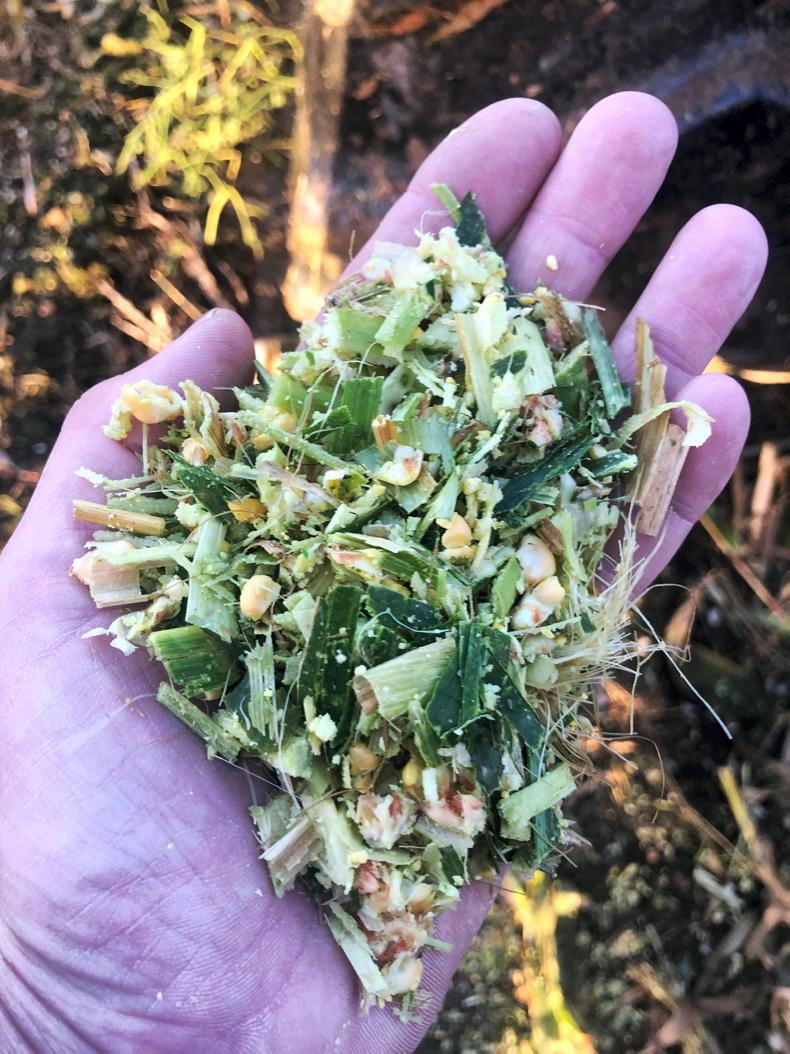
A sample of the maize that Tony has harvested.
The rest of the crop looks quite good. Tony is delighted with his system this year, from his strip-tillage planting system to his fertilisers and foliar applications. He says that the very early maturing varieties have been brilliant this year.
The triticale has got off to a great start. It now has two to three tillers on each plant. The humic acid that Tony applied seems to have had a good affect on the crop.
Tony direct drilled winter wheat in the two days after the maize harvest. He says that the ground conditions were some of the best he has seen at this time of year, and it was even dry enough to roll afterwards.
Graham was the main variety, but he also planted a small amount of a new variety, Olwyn. They were both planted at 165kg/ha.
Tony had not planned to plant as much wheat as he has done, but he says that the conditions were irresistible and will take some of the pressure off in the spring. The earlier planted wheat has emerged and looks well. Tony will apply 15l/ha of humic acid and an aphicide at the three-leaf stage.
Alistair is wrapping up the last of the fieldwork this week with some spraying.
He finished harvesting the maize last week. It yielded 12t/ac at 24% dry matter. Alistair says that he had one strip of maize and beans, with no sunflowers, and this did much better. Therefore, he will plant it again next year but he will reduce the rate of sunflowers.
He found it an easy crop to grow and is happy enough with how it went considering the sunflowers shaded out the maize a lot.
The spring beans were also wholecropped. They yielded 7.5t/ac at a dry matter of between 27 and 30%. Alistair was very happy with this, and says that some clover at the base of the plants helped to bulk up the beans, and it should provide good feeding for the milking cows.
Alistair direct drilled wheat into the stubbles of both these crops. He says that conditions were lovely, and even though the fields are quite wet in general, not one mark was left. Pre-emergence herbicides are being applied to these crops this week.
The winter barley that
was sown at the end of
September has emerged very
well and has three leaves. Alistair applied a post-emergence herbicide of Shooter to the crop at the full-rate, but he has been very disappointed with the weed control provided, especially with annual meadow grass, but also with some broadleaved weeds.
Therefore, he went in again last week and applied Octavia Met. He will also apply some manganese, zinc, and milk to the crop shortly.
The winter beans are just starting to emerge, while the spring oats that they were planted with should be killed off by the frost. The spring beans that were a companion crop to the failed oilseed rape are doing very well along with some oats that were broadcast onto the field. Alistair hopes to wholecrop this in April before planting maize.
The harvest finished for Pádraig last Wednesday night with the last 6ha of spring beans just before heavy rain arrived, and unusually, he had finished all of his winter planting except for this field beforehand. This field was then planted on Sunday morning to complete Pádraig’s winter planting plan.
Pádraig was sick of looking at the beans after waiting for so long to harvest them. He does not know the yield yet as they have not been delivered, but the moisture content is a minimum of 33% as the moisture meter will not read any higher than that. He has tipped them in the shed, but only at a height of 3ft and is turning them every morning to try to prevent them from heating.
Thirty acres of the spring beans were harvested on 11 October, and within 28 hours of starting to cut them, the field was fully planted with winter barley. The variety was Integral and the crop has emerged very nicely.
Pádraig is giving wheat one more chance on his farm as there is one field not suited to barley, and the seedlings are just starting to peep through. He has applied no herbicides yet as he was busy getting planting completed before showers of rain and the timings just did not suit.

Pádraig had his combine, plough, and drill working in the same field recently.
The winter oats have also been planted. The varieties are WPB Isabel and Husky, which make up 60% and 40% of the oats acreage respectively.
Pádraig has been very impressed with his new plough and the extra output it provides. He is ploughing at a furrow width of 18.5” and can cover 36ac in one day.
This is providing him with independence and flexibility as he does not need to rely on a contractor to ensure that the seed drill does not have to stop to wait for ploughing to be completed.
The maize harvest has started for Tony, with the majority of the crop still to be cut in the coming week or two. The maize has been very slow to ripen, but the cobs have ripened well recently. However, the leaves are still very green as Tony has not had any frost in his coastal location. There is a superb cob yield this year despite the late planting.
Tony is delighted with the quality of the maize that has been harvested so far, with great ground conditions helping to make harvesting easier. The 40ac harvested so far is probably the worst of the maize as it was late sown and endured cold, harsh, drought conditions. It still did not do too badly for Tony.

A sample of the maize that Tony has harvested.
The rest of the crop looks quite good. Tony is delighted with his system this year, from his strip-tillage planting system to his fertilisers and foliar applications. He says that the very early maturing varieties have been brilliant this year.
The triticale has got off to a great start. It now has two to three tillers on each plant. The humic acid that Tony applied seems to have had a good affect on the crop.
Tony direct drilled winter wheat in the two days after the maize harvest. He says that the ground conditions were some of the best he has seen at this time of year, and it was even dry enough to roll afterwards.
Graham was the main variety, but he also planted a small amount of a new variety, Olwyn. They were both planted at 165kg/ha.
Tony had not planned to plant as much wheat as he has done, but he says that the conditions were irresistible and will take some of the pressure off in the spring. The earlier planted wheat has emerged and looks well. Tony will apply 15l/ha of humic acid and an aphicide at the three-leaf stage.






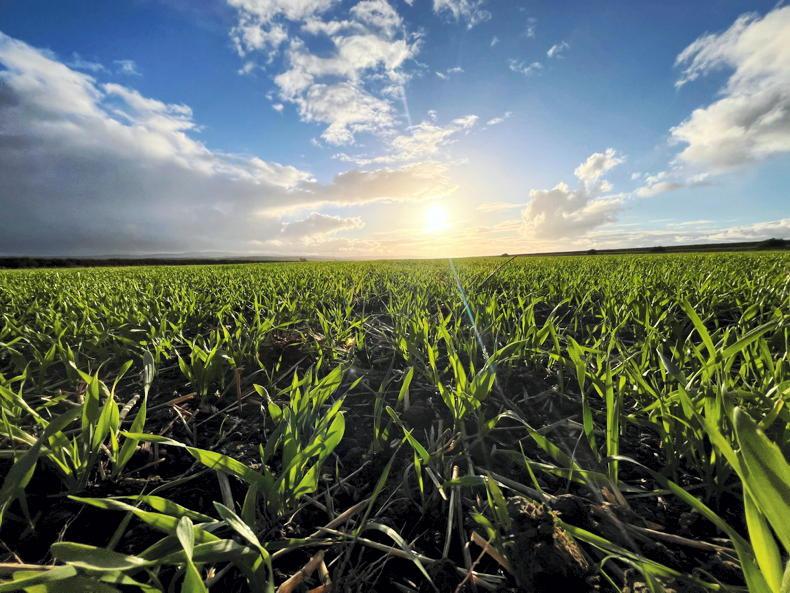

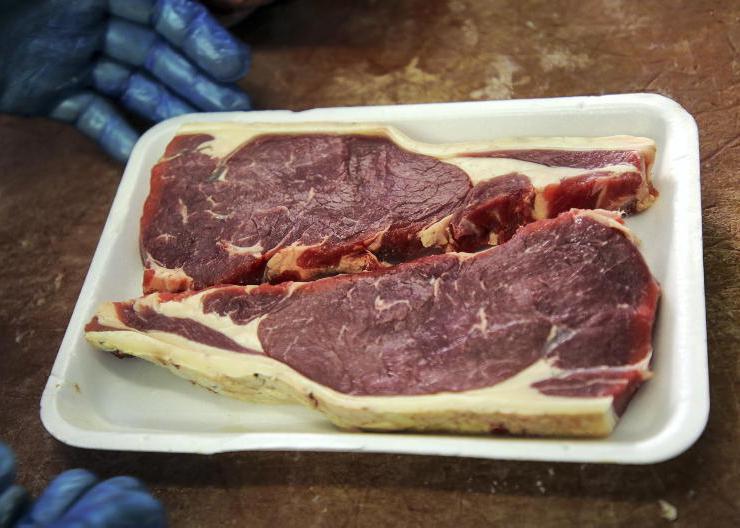

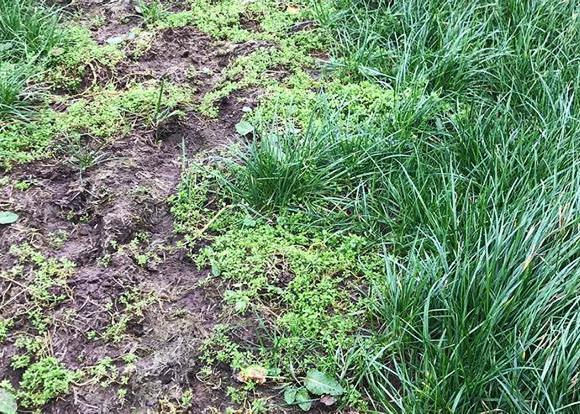
SHARING OPTIONS